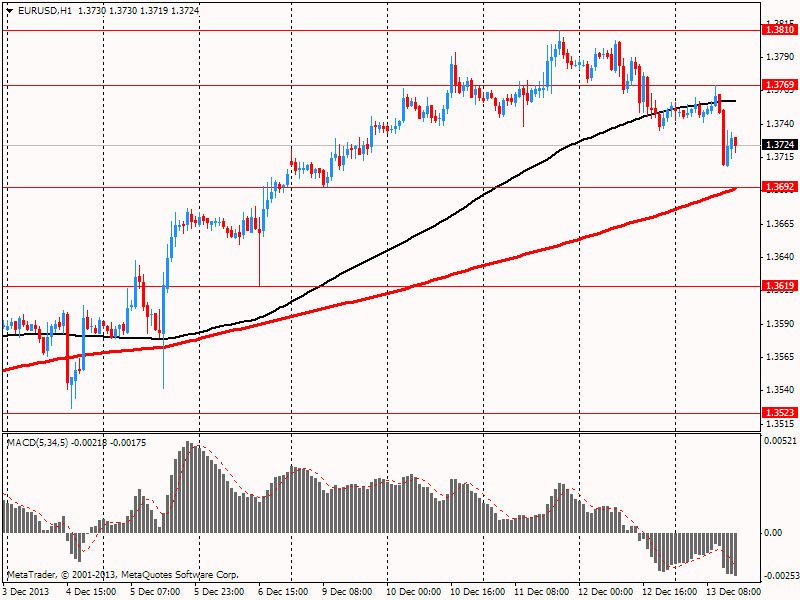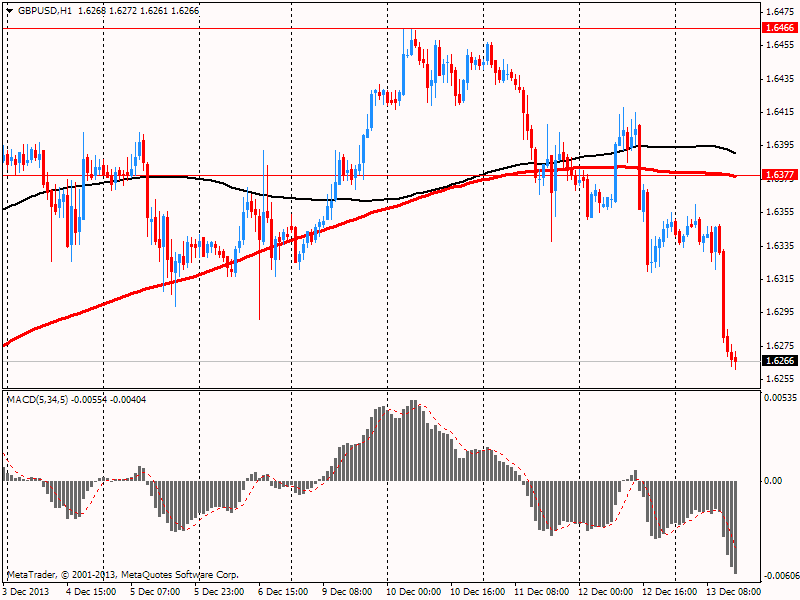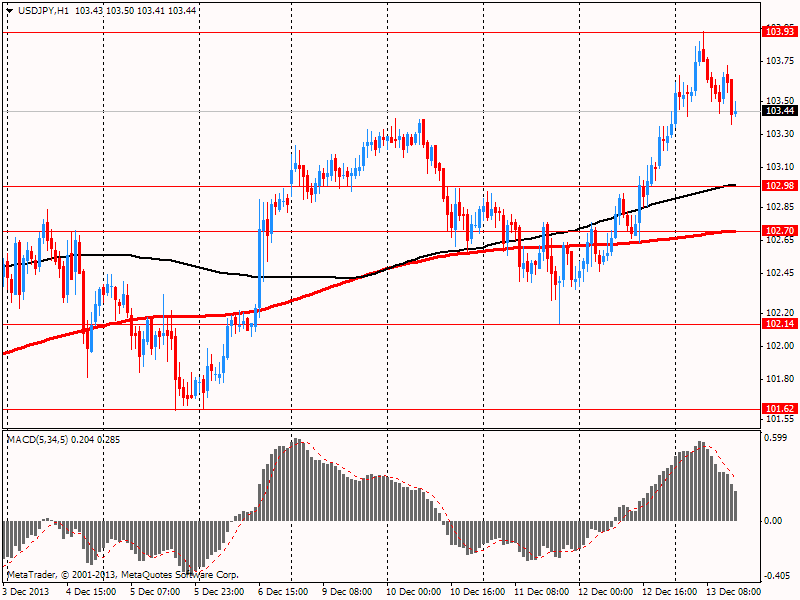Notícias do Mercado
-
19:21
American focus : the euro fell
The euro exchange rate fell sharply earlier against the dollar, which was associated with the release of the employment report in the eurozone. In statistical agency Eurostat reported that employment in the euro area remained unchanged during the third quarter . Add that employment has not changed for the second consecutive quarter . As it became known , the seasonally adjusted number of persons employed in the euro area remained unchanged at the end of the third quarter. Meanwhile, we note that the annualized employment decreased by 0.8 percent in the three months to September , which followed after falling 1.1 percent in the previous quarter .
In the European Union (EU ), employment has remained unchanged in the third quarter as it was in the second quarter . In annual terms, employment in the EU fell by 0.3 percent last quarter, compared with a fall of 0.6 percent in the second quarter .
Statistical agencies reported that among the Member States , Portugal, Ireland and Luxembourg recorded the highest rate of employment growth ( qoq ) . At the same time , Estonia, Lithuania , Cyprus , Finland, Greece registered the largest decrease in the number of employees.
Recall that the unemployment rate in the 17 countries of the eurozone in October fell to 12.1 % from 12.2 % in September , while the experts did not predict change indicator. Within two months ( August and September) keeps unemployment at a record level of 12.2 % , and the decline is a sign the labor market recovery after the release of the most prolonged recession in the history of the eurozone.
Yen falls seventh week against the U.S. dollar on the eve of the U.S. central bank meetings and Japan, which will be held next week. Expectations as to what the Federal Reserve may soon curtail the program to stimulate the economy continued to dominate the financial markets , pushing the Japanese yen to reach a new five-year low against the U.S. dollar . In today's trading in the Asian session , the dollar / yen hit Y103.93, its highest level since September 2008 .
The focus of investors still remained the upcoming Fed meeting , which is scheduled for December 17-18 . Many expect that the central bank will decide on its program minimized by buying bonds in the amount of 85 billion dollars a month. This contributed to the strengthening of the dollar against the yen. Published on Thursday strong retail sales data also pushed the U.S. currency to further growth .
Although the Fed sketched an exit plan from the current policy of "cheap money " , investors also expect further easing of monetary policy the central bank of Japan , putting more pressure on the yen .
Cpred yield between U.S. bonds and Japanese government bonds widened to a maximum since April 2011 . Yen reached a five-year low against the euro and is on track for the fifth consecutive week of decline.
During the U.S. session data released on producer prices in the U.S., which weakened the dollar . They showed that U.S. producer prices fell again last month, while fixing the third monthly decline in a row, which is the latest sign of easing inflation.
According to the report , the producer price index fell last month by 0.1 %, reflecting the continuing decline in energy prices. Basic prices , which exclude volatile components such as food and energy , rose 0.1%.
Many experts predicted that overall prices will remain unchanged after declining by 0.2 % in the previous month , and the basic prices will increase by 0.1 % , after rising 0.1 % in October.
In addition, data showed that the annual rate of producer price inflation rose moderately - by 0.7 %, compared with an increase of 0.3 % in October , but still remained historically weak. Add that economists were expecting a little more growth , namely at the level of 0.8%.
Today's report underscores the weak demand in the U.S. and abroad constrains core inflation. Producer prices may give a sense of where the inflation at the consumer level , as firms can charge higher prices for goods and services to offset their own cost increases.
Reducing inflation is putting pressure on the Fed , namely their decision to reduce the amount of its bond-buying program , which is designed to reduce long-term interest rates and stimulate investment . Officials have discussed a few months , when it is necessary to reduce the data buying amid fears about the risks and signs that the economy is gaining momentum.
-
13:45
Option expiries for today's 1400GMT cut
USD/JPY Y102.50, Y102.70, Y103.00, Y103.25, Y103.50, Y104.00, Y105.00
EUR/JPY Y142.00
EUR/USD $1.3600, $1.3700, $1.3750, $1.3760, $1.3800, $1.3810
GBP/USD $1.6360
GBP/USD Y168.50
USD/CHF Chf0.9000
AUD/USD $0.8820, $0.8950, $0.9000, $0.9010, $0.9020, $0.9100, $0.9160
NZD/USD $0.8200, $0.8275
NZD/JPY Y84.50
USD/CAD C$1.0590, C$1.0595, C$1.0600, C$1.0615, C$1.0640, C$1.0750
-
13:31
U.S.: PPI excluding food and energy, m/m, November +0.1% (forecast +0.1%)
-
13:31
U.S.: PPI, y/y, November +0.7% (forecast +0.8%)
-
13:31
U.S.: PPI excluding food and energy, Y/Y, November +1.3% (forecast +1.4%)
-
13:30
U.S.: PPI, m/m, November -0.1% (forecast 0.0%)
-
13:15
European session: the pound fell sharply against the U.S. dollar
Dats
4:30 Japan Industrial Production m / m (final ) October +0.5 % +0.5 % +1.0 %
4:30 Japan Industrial Production y / y (final ) October +4.7 % +4.7 % +5.4%
8:15 Switzerland PPI and import , m / m in November -0.4% +0.3 % -0.1 %
8:15 Switzerland PPI and import y / y in November -0.3% -0.3 % -0.4 %
8:45 Great Speech BOE Mark Carney
12:30 Speech UK BoE chief economist Spencer Dale
Rate of the euro fell sharply against the dollar, which has been associated with the release of the employment report in the eurozone. In statistical agency Eurostat reported that employment in the euro area remained unchanged during the third quarter. Add that employment has not changed for the second consecutive quarter . As it became known , the seasonally adjusted number of persons employed in the euro area remained unchanged at the end of the third quarter. Meanwhile, we note that the annualized employment decreased by 0.8 percent in the three months to September , which followed after falling 1.1 percent in the previous quarter .
In the European Union (EU ), employment has remained unchanged in the third quarter as it was in the second quarter . In annual terms, employment in the EU fell by 0.3 percent last quarter, compared with a fall of 0.6 percent in the second quarter .
Statistical agencies reported that among the Member States , Portugal, Ireland and Luxembourg recorded the highest rate of employment growth ( qoq ) . At the same time , Estonia, Lithuania , Cyprus , Finland, Greece registered the largest decrease in the number of employees.
Recall that the unemployment rate in the 17 countries of the eurozone in October fell to 12.1 % from 12.2 % in September , while the experts did not predict change indicator. Within two months ( August and September) keeps unemployment at a record level of 12.2 % , and the decline is a sign the labor market recovery after the release of the most prolonged recession in the history of the eurozone.
Pound fell substantially against the U.S. currency , as many market participants were waiting for the intervention of the Bank of England's Dale .
Also the focus of the market are U.S. data on producer prices , which will be presented later. After their publication in the focus of the market will be a meeting of FOMC. Recall that the Fed will hold its last meeting in 2013 on Tuesday and Wednesday next week. Data released earlier this week, was better than expected, prompting some analysts to raise GDP growth forecast in the fourth quarter by as much as half a percentage point to 2.2 percent on an annualized basis .
Also had little impact statements Andrew Haldane , executive director of the Bank of England's financial stability. He said that " the UK housing market recovery has spread to all regions of the country , but is still in the early stages ." "Now is not the time to slow down the housing market or any other market , as we are in the very early stages of recovery. But we have said that now is the time , do not push on the brake pedal , and at least loosen the gas pedal . "
Last month, the Bank of England said it would cut its support to mortgage lending in the UK in response to growing concerns about a sharp rise in activity in the housing sector , which , ultimately , can create trouble for banks and borrowers.
.
EUR / USD: during the European session, the pair fell to $ 1.3706 , but later recovered slightly
GBP / USD: during the European session, the pair fell to $ 1.6260
USD / JPY: during the European session, the pair rose to Y103.93, then fell to Y103.35
At 13:30 GMT the U.S. producer price index will be released and the producer price index excluding prices for food and energy in November.
-
13:00
Orders
EUR/USD
Offers $1.3850, $1.3830/35, $1.3815/20, $1.3790-805
Bids $1.3720/00, $1.3670/65, $1.3650, $1.3620
GBP/USD
Offers $1.6420/30, $1.6395/400, $1.6380, $1.6360
Bids $1.6275/70, $1.6250, $1.6240, $1.6220
AUD/USD
Offers $0.9045/50, $0.9020, $0.8980, $0.8960/70, $0.8945/50
Bids $0.8900, $0.8880, $0.8850, $0.8832
EUR/JPY
Offers Y143.50, Y143.20, Y143.00, Y142.45/50
Bids Y142.00, Y141.80, Y141.50, Y141.25/20, Y141.00
USD/JPY
Offers Y105.00, Y104.75, Y104.50, Y104.40, Y104.15/20, Y104.00
Bids Y103.20, Y103.00, Y102.77, Y102.50
EUR/GBP
Offers stg0.8500, stg0.8475/80, stg0.8440/50, stg0.8430
Bids stg0.8410, stg0.8380, stg0.8355/45, stg0.8330/20
-
10:20
Option expiries for today's 1400GMT cut
USD/JPY Y102.50, Y102.70, Y103.00, Y103.25, Y103.50, Y104.00, Y105.00
EUR/JPY Y142.00
EUR/USD $1.3600, $1.3700, $1.3750, $1.3760, $1.3800, $1.3810
GBP/USD $1.6360
GBP/USD Y168.50
USD/CHF Chf0.9000
AUD/USD $0.8820, $0.8950, $0.9000, $0.9010, $0.9020, $0.9100, $0.9160
NZD/USD $0.8200, $0.8275
NZD/JPY Y84.50
USD/CAD C$1.0590, C$1.0595, C$1.0600, C$1.0615, C$1.0640, C$1.0750
-
08:16
Switzerland: Producer & Import Prices, m/m, November -0.1% (forecast +0.3%)
-
08:16
Switzerland: Producer & Import Prices, y/y, November -0.4% (forecast -0.3%)
-
07:37
Asian session: Japan’s currency headed for a seventh weekly drop
04:30 Japan Industrial Production (MoM) (Finally) October +0.5% +0.5% +1.0%
04:30 Japan Industrial Production (YoY) (Finally) October +4.7% +4.7% +5.4%
Japan’s currency headed for a seventh weekly drop against its U.S. peer before the Federal Reserve and the Bank of Japan hold policy meetings next week.
The yen also touched its lowest in five years versus the euro, set to complete a five-week decline, before European Central Bank Vice President Vitor Constancio and executive board members Benoit Coeure and Peter Praet speak today. ECB policy makers Peter Praet and Benoit Coeure are also scheduled to speak separately in Antwerp and Paris today. Praet told Bloomberg Television on Nov. 14 that the bank may adopt negative rates as it battles slow inflation. Coeure said this month the ECB would consider offering more long-term loans to banks only when they are in a position to lend to companies and households.
Australia’s dollar headed for an eight-week loss as Reserve Bank Governor Glenn Stevens signaled a weaker currency is preferable over lower interest rates. It touched a more-than-three month low of 89.14 U.S. cents after he said 85 cents ‘‘would be closer to the mark than 95 cents,’’ in an interview in the Australian Financial Review today.
EUR / USD: during the Asian session, the pair traded in the range of $ 1.3740-60
GBP / USD: during the Asian session, the pair traded in the range of $ 1.6330-60
USD / JPY: during the Asian session, the pair rose to Y103.95
There is a much quieter calendar Friday, with even the data schedule having a Christmas feel. Early European data sees German November wholesale prices released at 0700GMT, with the Bank of France retail trade data released at 0730GMT. At 0800GMT, Spain's November final HICP numbers will cross the wires. Analysts sees the number flat on month, with the final year-on-year coming in at +0.3%. Also at 0800GMT, BOE Governor Mark Carney, BOF Governor Christian Noyer and ECB Executive Board Member Benoit Coeure attend a French Treasury Conference taking place in Paris. Further European data is expected at 1000GMT, when the EMU third quarter employment numbers are released. There are further comments from ECB officials expected at 1115GMT, when Executive Board member Peter Praet delivers a speech on "The Role of the ECB in Times of Crisis," in Antwerp, Belgium. There is little on the US calendar, with just the November PPI data expected at 0830ET. The PPI is expected to be unchanged in November after an energy-led decline in October. Core PPI is forecast to rise 0.1%. Analysts see energy prices falling in the month, while a plunge in farm prices received suggests that food prices declined in November after rebounding in October. -
06:42
Schedule for today, Friday, Dec 13’2013:
04:30 Japan Industrial Production (MoM) (Finally) October +0.5% +0.5% +1.0%
04:30 Japan Industrial Production (YoY) (Finally) October +4.7% +4.7% +5.4%
08:15 Switzerland Producer & Import Prices, m/m November -0.4% +0.3%
08:15 Switzerland Producer & Import Prices, y/y November -0.3% -0.3%
08:45 United Kingdom BOE Gov Mark Carney Speaks
12:30 United Kingdom BOE Chief Economist Spencer Dale Speaks
13:30 U.S. PPI, m/m November -0.2% 0.0%
13:30 U.S. PPI, y/y November +0.3% +0.8%
13:30 U.S. PPI excluding food and energy, m/m November +0.2% +0.1%
13:30 U.S. PPI excluding food and energy, Y/Y November +1.4% +1.4%
-


